
|
Back to |
| The Front Page |
| The Game |
|
Perfecting the Golf Croquet Celebrity Exhibition Format |
|
by Bob Alman photos by Johnny Mitchell except where noted layout by Reuben Edwards Posted March 11, 2012
|
A belief that Golf Croquet is the best route to promoting the growth of croquet club membership is becoming almost an article of faith in most croquet-playing countries. The sometimes vociferous opposition to that notion seems to be based mostly on the fear that it will be so successful in generating numbers that the more "serious" players of Association Croquet will somehow be squeezed out of court time. Golf Croquet adherents say that won't happen, because most of the recruits will "promote" themselves to the traditional form of the game. In the meantime the USCA embarks on a second year of methodically developing an optimum format that calls for having star players of the game compete in highly-publicized exhibition games in a "stadium" environment augmented with amplified play-by-play commentary and scoreboards. These photos chronicle the USCA Golf Croquet Celebrity Exhibition of February 25, 2012 at the National Croquet Center in West Palm Beach.
Lots of things were done right.
The players, after all, were the current world champion, Mark McInerney of Ireland, versus the Egyptian three-time world champion Khaled Younis.
The place was the National Croquet Center, which can accommodate hundreds of spectators and sell them drinks and lunch on the broad wrap-around veranda overlooking the center courts.

|
| QUESTION: Where's the real hero in this picture? ANSWER: It's David McCoy, unpaid Acting General Manager of the National Croquet Center, on the left boundary. After setting up and testing the sound system and helping to secure the barriers, he volunteered himself as a ball boy. At the microphone with Bob Alman, Amir Ramsis commented, "In Egypt we pay the ball boys." John Warlick photo. |
The occasion was the 5th annual International Polo Club Palm Beach Golf Croquet purse invitational, for the second year (and probably permanently) played as Golf Croquet. The sponsoring croquet club, in Wellington, has only one lawn, so many extra lawns were used at the NCC, almost 30 minutes away in driving time.
| THE TWO-MINUTE GOLF CROQUET VIDEO |
|
If you agree that a two-minute real-time video of champion players with explanatory voice-over could be the vitally needed "open sesame" to abundant newsprint and TV coverage of croquet, maybe you'll produce it yourself. Or perhaps you have useful suggestions on who/what/where/why/how it could be done. You're invited to self-post comments and suggestions in our FORUM.
|
So what was missing? In my opinion, about 200 more guests could have been accommodated, in addition to the estimated 130 non croquet players present; also missing was the kind of press that causes readers and TV viewers to go out of their way to see a croquet spectacle: the kind of press that could have made the critical difference, whether in print or on television.
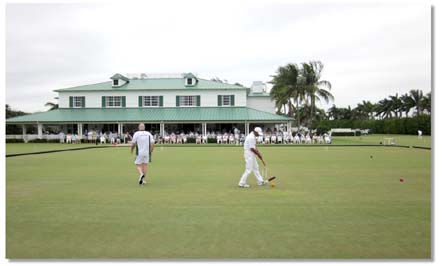
|
| Except for the few moments it takes to stalk a ball and prepare a swing, there are few static interludes in Golf Croquet singles, for either player. In the background, overflowing the broad veranda of the National Croquet Center, is a huge crowd, measured by American croquet norms. But, "In Egypt," Amir Ramsis commented, "we have 2,000 spectators for a big match." John Warlick photo. |
Yes, there were press releases and there were plenty of notices in the local press. But the problem--especially in Palm Beach County, where the USCA was organized in the late 70's--is that most people already think they know what croquet looks like, from former exposure: they "know" it's excruciatingly slow, that one player can be on the court alone for 15 minutes moving the balls around in inexplicable ways; they "know" the game is impossible to understand, incredibly boring, and mostly done by old people.
That knowledge, as applied to Golf Croquet, is not at all accurate. But just saying that in a press release, or on the phone to a writer or a TV assignment editor, doesn't get the point across. You can explain, with intensity and genuine enthusiasm, "This is not at all the game you've seen before. It's very interactive, only one stroke per turn. It features hard hitting by players whose accuracy will amaze you--so hard-hitting that spectators have to be protected from hard-hit balls by barriers. This is a spell-binding spectator game!"
You can say all that--as I have done, many times--and they still won't get it, even after you show them still pictures like the ones in this article. That's precisely the problem. They are STILL PICTURES.
Which suggests to this organizer and observer that the potential breakthrough in publicity needs to come from MOVING PICTURES. It's the only way to quickly demonstrate the fast pace of the game, as well as its simple rules.
If you search your files and YouTube looking for the right two-minute clip to show to writers and TV assignment editors, you will likely find, as I did, that it does not yet exist. Which means, simply, that the essential component of a press release that could conceivably create an entirely new generation of publicity for croquet to fire the global growth of membership and clubs has yet to be created: a quick link to a well-crafted short video.
Which means, in turn, that the next step of development is self-evident.
When you think about it--and I have, a lot--you realize that what is needed is a short REAL-TIME video (no cuts in the action) to show how fast-moving the game is, with a voice-over sufficient to completely explain the game; and a camera that includes a view of a gallery of spectators glued to the action. (Look at the spectators in this story, and you can easily imagine it.)
What is needed, in short, is a video of just one two-minute segment of the exciting game between McInerney and Younis at the National Croquet Center on February 25. Or, since that didn't happen, a real-time rendition of another event with similar components.
The USCA president stepping down in early 2012 after a three-year term is especially interested in the future of Golf Croquet as a vehicle for promoting the sport. Carolinian Gene Young has been involved in two of the four editions of the series, and he's working on a third one scheduled for September 2012 at Toxaway resort in North Carolina. Johnny Mitchell, incoming president of the USCA, is also an enthusiastic supporter of the format and made it a feature of the organization's Annual Planning Meeting in March 2012 at the National Croquet Center. Mitchell himself shot most of these excellent photographs on February 25.
The question now is: Who will produce the two-minute video which, once done, can be used by every croquet publicist in the English-speaking world? If you have the answer, or a comment, you're invited to make it known either privately or publicly in our linked FORUM conversation.
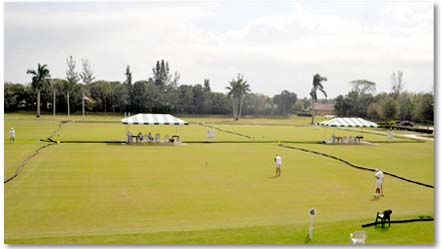
|
| It's late morning on an overcast Saturday, and the final tense matches in the best-of-three round robin of the International Polo Club's Golf Croquet TOURNAMENT OF CHAMPIONS are being played out on four courts at the National Croquet Center, photographed from the upstairs club house ballroom. The lightweight irrigation pipes were first used at the Center for the first major international event held there: the Golf Croquet World Championship in February, 2002. Almost ten years later, the center court is being prepared for an exhibition match between the Egyptian who won that 2002 world championship and the current world champion--the first non-Egyptian ever to win the title. |
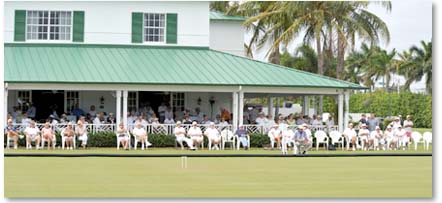
|
| Waiting for the action to begin is the biggest crowd ever assembled in America for such an exhibition. |
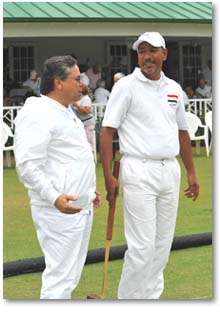 Amir Ramsis has visited the area many times before, but this is his first visit since becoming president of the World Croquet Federation late last year. Fluent in English, as most Egyptian players are not, he is accustomed to accompanying the Egyptian players to events in English-speaking countries. Here he chats with his star player before the start of the exhibition match. |
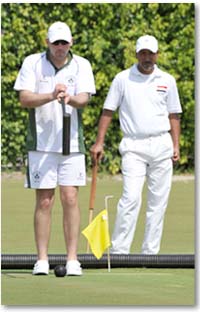 Mark McInerney wins the toss and begins the game in Corner Four, as the rules mandate. |
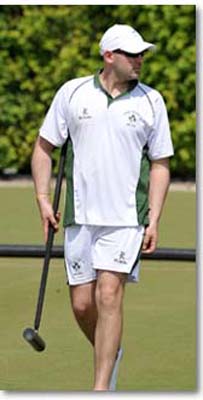
|
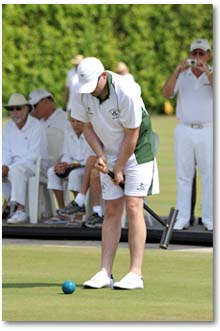 McInerney's backswing is not as high as the typical Egyptian's, but his swing is almost as powerful, and deadly accurate. |
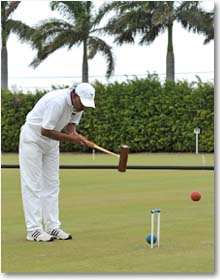 Part of the reason for the Egyptians' big backswing is the lighter weight of their mallets, requiring more energy to make the one-pound balls achieve the speed they need, in many strokes, to clear an opponent's ball completely off the court. |
 Are any of these spectators thinking of anything at all except Khaled Younis' shot at Hoop Three? |
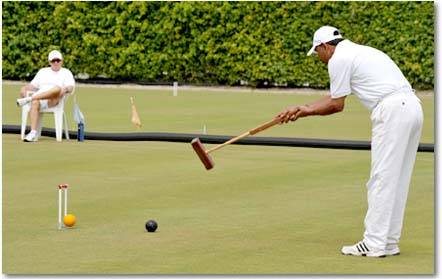
|
| Khaled Younis shows his usual impeccable form in taking the jump shot he needed to score Hoop Five. |
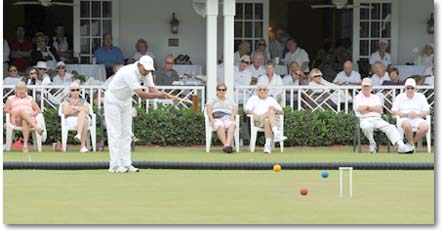
|
| How many croquet balls can Younis put into the air in a legal Golf Croquet stroke? |
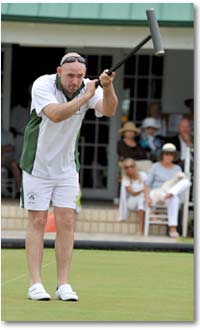
|
It's only an exhibition, but world champion Mark McInerney really wants to win it with his Pidcock mallet's straight swing and flawless follow-through. |
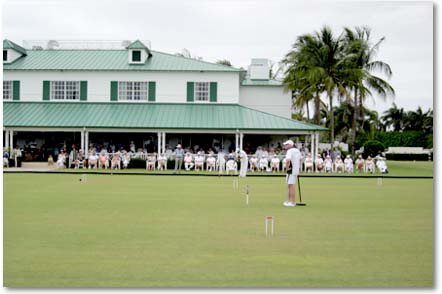
|
| In intensely interactive Golf Croquet, players typically stay on the lawn for the entire game, quietly waiting to prepare for their next shot. Mark is safely out of the line of sight here, by the peg. John Warlick photo. |
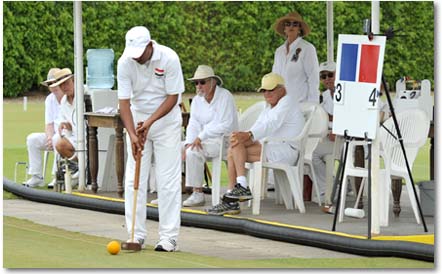
|
| The scoreboard shows Younis (red/yellow) leading Mark (blue/black) four to three as the champions contest the eighth point in front of one the mid-lawn gazebos that shelter spectator overflow. |

|
| The world champion looks on ruefully as Younis puts away the game to huge applause from the crowd. The Egyptian-style pyrotechnics enchanted the crowd, and it was enough to give Younis a 7-5 victory in the exhibition match. But Mark McInerney was to get his revenge the next day, when he took the finals match from Younis at International Polo in two straight games. |